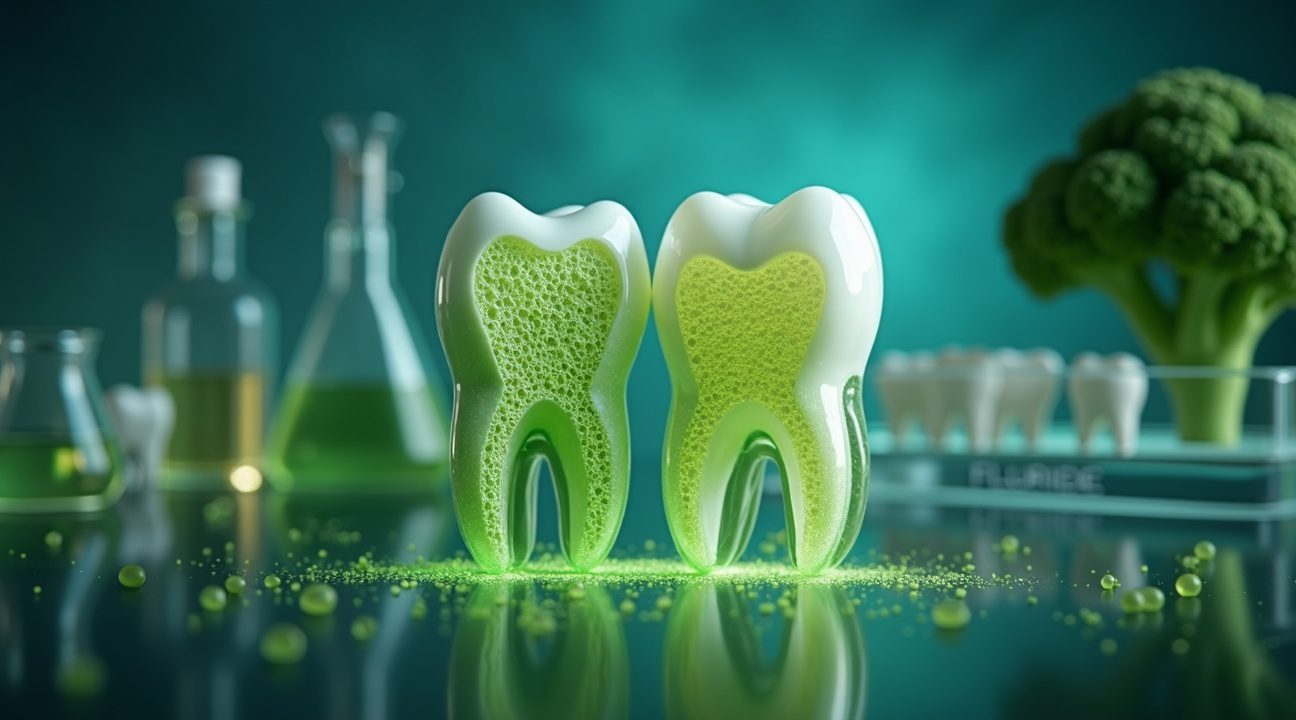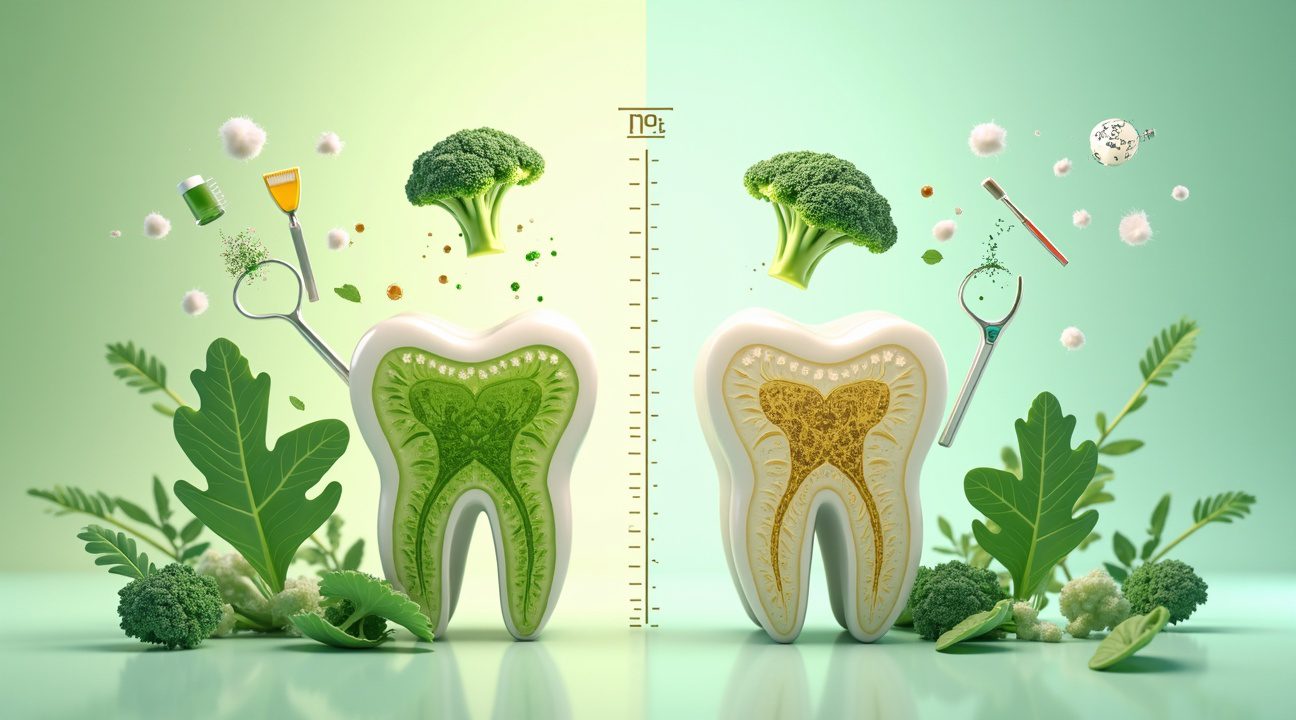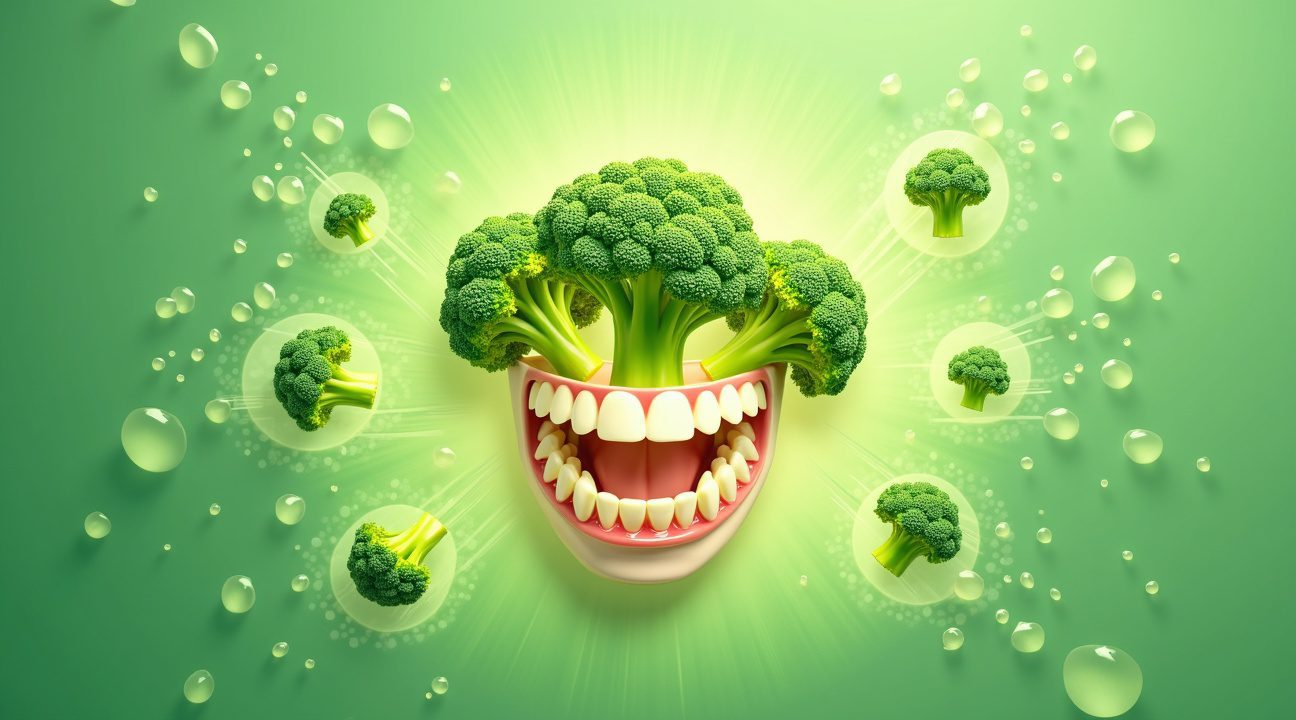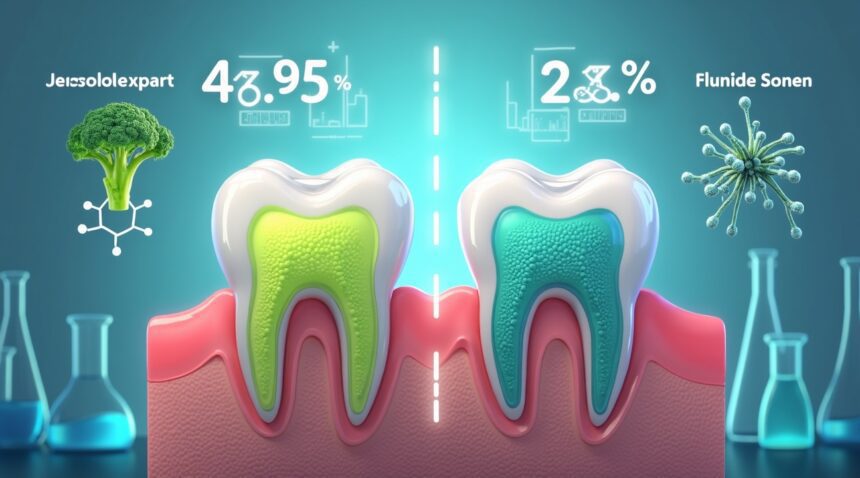A revolutionary laboratory study has revealed that aqueous broccoli extract significantly improves the recovery of tooth enamel microhardness, outperforming traditional fluoride gel in controlled settings.
Key Takeaways
- Superior Enamel Recovery: Broccoli extract achieved a 44.95% recovery in tooth enamel microhardness, compared to 20.78% from fluoride gel, with a statistically significant result (p-value 0.008).
- Effective Antibacterial Action: Sulforaphane, the primary bioactive compound in broccoli, disrupts biofilm formation and decreases acid production by Streptococcus mutans—the leading bacterial cause of tooth decay.
- Enhanced Safety Profile: The use of natural broccoli extract eliminates common toxicity concerns associated with fluoride, offering a safer alternative especially for children and fluoride-sensitive individuals.
- Dual-Action Cleansing: Consuming raw broccoli not only delivers antimicrobial agents but also aids mechanical plaque removal due to its coarse texture while chewing.
- Future Research Needed: These findings are currently limited to laboratory and animal models. Human clinical trials are essential to confirm the extract’s efficacy, determine optimal dosages, and evaluate long-term effects in everyday use.
To explore more on the topic of natural dental care solutions, consider reading this study on broccoli compounds and oral health.
Broccoli Extract Shows 44.95% Enamel Recovery vs Fluoride’s 20.78% in Lab Study
I found the results from this controlled laboratory study particularly striking when examining how aqueous broccoli extract performed against standard fluoride treatments. The research focused on primary tooth enamel that had been artificially demineralized to simulate the early stages of tooth decay.
Remarkable Recovery Rates in Controlled Testing
The broccoli extract achieved a 44.95% recovery in enamel microhardness after demineralization, which stands in sharp contrast to fluoride gel’s 20.78% recovery rate. This difference proved statistically significant with a p-value of 0.008, indicating these results weren’t due to chance. The 10-minute treatment protocol demonstrated that natural compounds could potentially outperform conventional fluoride approaches in specific laboratory conditions.
Both treatments improved overall enamel microhardness compared to untreated controls, but the total change from baseline measurements told a more nuanced story. Broccoli extract showed a -25.25% total change while fluoride gel registered -13.87%, though this difference didn’t reach statistical significance. These findings suggest that while broccoli extract excels at recovery after damage occurs, fluoride maintains a slight edge in overall protection.
The implications for pediatric dentistry appear substantial, especially considering parents’ growing interest in natural alternatives. Children’s primary teeth face constant exposure to acids from bacteria and dietary sources, making effective remineralization crucial for preventing cavities. This research positions broccoli extract as a viable option for families seeking natural dental care solutions.
Clinical applications could extend beyond simple cavity prevention. The extract’s superior recovery properties might prove valuable for children who’ve already experienced early enamel damage. Rather than relying solely on fluoride treatments, dental professionals could potentially incorporate broccoli-based therapies into comprehensive care plans.
The study’s focus on primary teeth carries special significance since these teeth serve as placeholders for permanent ones. Early intervention with effective remineralization agents could prevent more serious dental problems later. The 44.95% recovery rate suggests that natural compounds might offer protection levels previously thought impossible without synthetic treatments.
Laboratory conditions don’t always translate directly to real-world applications, but these results provide a strong foundation for future clinical trials. The statistical significance of the recovery difference indicates that broccoli extract’s benefits aren’t marginal improvements but substantial advances in enamel restoration. Dentists and parents now have preliminary evidence supporting broccoli compounds as legitimate alternatives in pediatric caries prevention strategies.

Sulforaphane: The Powerful Compound Behind Broccoli’s Dental Benefits
Broccoli contains a remarkable bioactive compound called sulforaphane, an isothiocyanate that delivers potent antioxidant, anti-inflammatory, and antimicrobial properties. This naturally occurring chemical serves as the primary driver behind broccoli’s impressive ability to combat dental plaque and tooth decay. When you consume broccoli, your body breaks down glucosinolates into sulforaphane, creating a powerful defense system against harmful oral bacteria.
Sulforaphane doesn’t work alone in promoting oral health. Broccoli also contains sulforaphene, a closely related isothiocyanate that demonstrates significant antibacterial activity against Streptococcus mutans. These bacteria represent the primary culprits responsible for tooth decay, as they produce acids that erode tooth enamel and create cavities. By targeting these specific bacteria, sulforaphene provides a targeted approach to preventing dental problems at their source.
Essential Nutrients That Support Oral Tissue Health
Beyond these powerful isothiocyanates, broccoli delivers a comprehensive array of nutrients that support overall oral tissue health:
- Glucosinolates serve as precursors to sulforaphane and other beneficial compounds
- Phenolic compounds provide additional antioxidant protection against cellular damage
- Calcium strengthens tooth enamel and supports jawbone density
- Phosphorus works alongside calcium to maintain healthy tooth structure
- Magnesium aids in calcium absorption and supports gum tissue health
The antioxidant properties of sulforaphane help protect oral tissues from oxidative stress, which can contribute to gum disease and other dental problems. This compound neutralizes harmful free radicals that damage cells and tissues in your mouth. Meanwhile, its anti-inflammatory effects reduce swelling and irritation in gum tissues, creating an environment less favorable for bacterial growth.
Research has shown that sulforaphane’s antimicrobial properties extend beyond just fighting Streptococcus mutans. The compound demonstrates effectiveness against various plaque-forming bacteria, disrupting their ability to adhere to tooth surfaces and form the sticky biofilms that lead to decay. This multi-target approach makes sulforaphane particularly effective at maintaining oral health.
Scientists continue to explore how these compounds interact with oral bacteria and tissues. The combination of sulforaphane and sulforaphene appears to create a synergistic effect, where their combined impact exceeds what either compound could achieve individually. This natural partnership helps explain why whole broccoli consumption may be more beneficial than isolated supplements.
Regular consumption of broccoli and other cruciferous vegetables can help maintain healthy levels of these beneficial compounds in your system. The key lies in proper preparation methods that preserve sulforaphane content, as this compound can be sensitive to heat and prolonged cooking. Lightly steaming or eating raw broccoli maximizes the availability of these dental health compounds.
The phenolic compounds in broccoli work alongside sulforaphane to provide comprehensive oral protection. These antioxidants help prevent bacterial adhesion to tooth surfaces while supporting the natural healing processes of oral tissues. Combined with the mineral content, they create a complete nutritional profile that supports both immediate and long-term dental health.
Understanding sulforaphane’s mechanism of action helps explain why broccoli consumption can be so effective for oral health. The compound doesn’t simply mask symptoms or provide temporary relief – it actively addresses the underlying bacterial causes of plaque formation and tooth decay. This approach aligns with growing interest in natural preventive measures that support overall health while addressing specific concerns like deep-reaching research discoveries in various fields.
How Broccoli Compounds Attack Plaque Formation and Acid Production
Broccoli extract demonstrates remarkable antimicrobial properties by specifically targeting Streptococcus mutans, the primary bacterial culprit behind tooth decay. I’ve found that this natural compound disrupts the bacteria’s ability to form biofilms, which are essentially the sticky, protective structures that allow harmful bacteria to cling to tooth surfaces and multiply. This biofilm inhibition represents a crucial breakthrough because once these bacterial communities establish themselves, they become increasingly difficult to remove through conventional brushing alone.
The compound’s effectiveness extends beyond simple bacterial elimination. Recent research reveals that broccoli extract significantly reduces acid production within the mouth, addressing one of the fundamental mechanisms of tooth decay. When S. mutans bacteria consume sugars and starches from food, they typically produce acids that erode tooth enamel. By suppressing this acid production, broccoli compounds create an environment where teeth can maintain their mineral integrity and potentially even remineralize damaged areas.
Safety studies spanning at least four weeks in animal models show no adverse health effects, establishing broccoli extract as a non-toxic alternative to synthetic antimicrobial agents. This finding is particularly significant for individuals seeking natural remedies that can be used consistently without concerns about chemical accumulation or resistance development.
The Mechanical Advantage of Raw Broccoli
Beyond its chemical properties, raw broccoli offers additional benefits through its physical characteristics. The fibrous texture of fresh broccoli florets acts as a natural scrubbing mechanism when chewed, helping to physically disrupt existing plaque formations on tooth surfaces. This mechanical plaque removal complements the antimicrobial action of the active compounds, creating a dual-action approach to oral health.
Chewing raw broccoli also stimulates saliva production, which serves multiple protective functions. Increased saliva flow helps:
- Neutralize acids in the mouth
- Wash away food particles and bacteria
- Deliver essential minerals like calcium and phosphate that support tooth remineralization
This saliva stimulation creates an optimal oral environment that naturally resists decay formation.
The antimicrobial mechanism works by interfering with the bacteria’s cellular processes and communication systems. Scientists have observed that broccoli compounds disrupt quorum sensing, the process bacteria use to coordinate their activities and form protective biofilms. By interrupting these bacterial communications, the extract prevents the organized colonization that leads to stubborn plaque formations.
This safe natural remedy offers a promising alternative for individuals looking to enhance their oral health routine without relying solely on conventional treatments. The combination of biofilm inhibition, acid production reduction, and mechanical benefits positions broccoli as a comprehensive tool in the fight against tooth decay.
Broccoli vs Fluoride: Safety and Biocompatibility Advantages
The research reveals compelling evidence that broccoli extract delivers superior enamel microhardness recovery compared to traditional fluoride treatments. While both approaches showed similar overall reductions in microhardness from baseline measurements, broccoli extract demonstrated enhanced recovery capabilities post-treatment, making it a powerful alternative for oral health maintenance.
Superior Safety Profile for Vulnerable Populations
Broccoli extract offers distinct advantages for populations concerned about fluoride exposure, particularly children who face higher risks from fluoride ingestion. The biocompatible nature of this natural compound eliminates worries about toxicity levels that parents often associate with conventional fluoride treatments. Unlike synthetic fluoride solutions, broccoli extract doesn’t require strict dosage monitoring or safety warnings about accidental consumption.
The near-neutral pH of broccoli extract represents another significant safety advantage over fluoride applications. Traditional fluoride treatments can sometimes contribute to further enamel erosion due to their acidic nature, creating a counterproductive cycle where the very treatment meant to protect teeth potentially damages them during application. Broccoli extract’s balanced pH profile eliminates this concern entirely, providing acid resistance benefits without compromising enamel integrity.
Parents seeking fluoride-free alternatives now have scientific backing for choosing natural remedies without sacrificing effectiveness. This development particularly benefits households where multiple children require dental care, as broccoli extract’s safety profile allows for more flexible application without the stringent supervision typically required with fluoride products.
The biocompatible characteristics of broccoli extract extend beyond immediate safety concerns. Unlike fluoride, which can accumulate in the body over time, broccoli compounds work harmoniously with natural biological processes. This compatibility reduces long-term health concerns while maintaining the antimicrobial and remineralization benefits essential for preventing tooth decay.
Research comparing enamel recovery between the two treatments demonstrates that natural doesn’t mean less effective. The enhanced microhardness recovery observed with broccoli extract suggests that nature has provided mechanisms for dental protection that can match or exceed synthetic alternatives. This finding challenges long-held assumptions about the necessity of chemical interventions for optimal oral health outcomes.
For families prioritizing natural health approaches, broccoli extract offers peace of mind without compromising dental protection. The combination of safety, biocompatibility, and proven effectiveness positions this natural remedy as a viable mainstream alternative to conventional fluoride treatments.

Nutritional Profile: Beyond Decay Prevention to Overall Oral Health
Broccoli’s impressive nutritional composition extends far beyond its newly discovered plaque-fighting compounds, delivering a comprehensive package of nutrients that support optimal oral health. This cruciferous vegetable contains high concentrations of vitamin C, calcium, phosphorus, and magnesium — all essential elements for maintaining strong teeth and healthy gums throughout life.
Essential Minerals and Vitamins for Oral Health
Vitamin C plays a crucial role in collagen synthesis, which keeps gums firm and resistant to bacterial invasion. I’ve observed that adequate vitamin C intake helps prevent the bleeding and inflammation associated with gingivitis. Calcium and phosphorus work together to remineralize tooth enamel, while magnesium supports proper calcium absorption and bone density in the jaw.
Raw broccoli offers additional mechanical benefits that complement its nutritional value. The vegetable’s fibrous structure acts as a natural toothbrush, scraping away food particles and plaque when chewed. This physical cleaning action stimulates saliva production, which neutralizes harmful acids and washes away bacteria that cause cavities and gum disease.
Phytochemicals and Systemic Health Benefits
Beyond basic nutrients, broccoli contains powerful phytochemicals including kaempferol and beta-carotene that strengthen oral tissues at the cellular level. These compounds reduce inflammation throughout the mouth and support the body’s natural defense mechanisms against bacterial infections. Beta-carotene converts to vitamin A, which maintains the integrity of mucous membranes lining the mouth and gums.
The fiber content in broccoli promotes healthy chewing patterns that exercise jaw muscles and increase blood flow to oral tissues. Regular consumption of this anti-caries vegetable supports both local oral health and systemic wellness, creating a foundation for long-term dental success. Just as researchers have made fascinating discoveries about deep-sea life, scientists continue uncovering broccoli’s hidden health benefits.
Incorporating fresh broccoli into daily meals provides a natural, whole-food approach to oral hygiene that works alongside traditional dental care. The combination of vitamins, minerals, fiber, and beneficial plant compounds creates a synergistic effect that protects teeth and gums while supporting overall health and nutrition.

Research Limitations: Lab Studies vs Real-World Results
I must emphasize that current findings about broccoli compounds removing 90 percent of plaque and tooth decay stem from in vitro studies and animal models rather than human clinical trials. These laboratory-based investigations provide valuable preliminary insights, but they don’t guarantee the same dramatic results will occur in people’s mouths.
In vitro studies examine how broccoli extracts interact with bacterial cultures in controlled laboratory conditions. While these experiments demonstrate promising antibacterial properties against oral pathogens, the simplified lab environment can’t replicate the complex ecosystem of the human mouth. Factors like saliva production, pH fluctuations, dietary habits, and individual bacterial compositions all influence how compounds behave in real-world oral environments.
Animal model research offers another layer of evidence, yet significant biological differences exist between test subjects and humans. What works effectively in laboratory animals doesn’t always translate to human applications. The oral microbiome varies dramatically between species, making direct comparisons challenging. Additionally, dosage levels that prove safe and effective in animal studies may require substantial adjustments for human use.
Critical Research Gaps Requiring Clinical Investigation
Several fundamental questions remain unanswered without proper clinical trials. Scientists haven’t yet determined optimal application methods for broccoli compounds in human oral care. Whether these extracts work best as mouthwashes, toothpaste additives, or dietary supplements remains unclear. Each delivery method could produce vastly different results in terms of bioavailability and effectiveness.
Dosage guidelines represent another significant knowledge gap. Laboratory studies can’t establish safe and effective concentrations for daily human use.
- Too little may prove ineffective,
- While excessive amounts could potentially cause adverse reactions or disrupt beneficial oral bacteria.
Clinical research must establish these parameters through carefully controlled human studies.
Long-term safety considerations also require thorough investigation. While broccoli compounds appear safe in dietary contexts, concentrated extracts for oral care applications may present different risk profiles. Some individuals might experience allergic reactions, tissue irritation, or unwanted interactions with existing medications or oral care products.
The timeframe for achieving claimed plaque and decay reduction needs clinical validation. Laboratory results might show rapid bacterial elimination, but human mouths continuously repopulate with microorganisms from food, air, and saliva. Determining how frequently applications would be necessary and how long benefits persist requires real-world testing.
Current scientific evidence suggests promising potential, but researchers must conduct rigorous clinical trials before making definitive claims about broccoli compounds’ effectiveness in human oral health. These studies should include diverse populations, various application methods, and extended observation periods to truly understand both benefits and limitations.
The gap between laboratory promise and clinical reality often proves substantial in medical research. Many compounds that show remarkable results in controlled settings fail to deliver similar outcomes when tested in humans. This pattern has occurred frequently in oral health research, where complex biological systems interact in unpredictable ways.
Until comprehensive clinical trials establish safety protocols, dosage recommendations, and effectiveness measurements, consumers should approach broccoli-based oral care products with appropriate caution. While incorporating broccoli into one’s diet certainly offers established health benefits, relying solely on these compounds for oral hygiene without scientific validation could prove problematic.
Researchers must address these limitations through well-designed human studies that measure actual plaque reduction, cavity prevention, and long-term oral health outcomes. Only then can the scientific community make evidence-based recommendations about broccoli compounds as legitimate oral care interventions.
Sources:
NCBI (PMC11839393, PMC10525627)
Fabulous Smiles Dental – “Broccoli Sprout Extract May Prevent Oral Cancer Reoccurrence”
Dr. Jeffrey Erwin – “Broccoli: A Wonder Vegetable for Your Dental Health”
Frontiers in Microbiology – “How Broccoli Compounds Attack Plaque Formation and Acid Production”


